

the wor lds of John Ruskin




the wor lds of John Ruskin


Opposite: Mountain Rock and Alpine Rose, 1844 (or perhaps 1849)
One of Ruskin’s most beautiful ear ly drawings , this was probably brought to completion on the spot, almost cer tainly in the region of Chamonix in 1844 or 1849 The pencil under-drawing is quite hasty, with the rocks and trees outlined in ink, but only simple watercolour wash and a little red chalk added In a diar y entr y from June 1849, Ruskin enthused over ‘the Alpine rose clinging to its war m and tiger-str iped crags , the pines above stretching their ar ms over one ’ s heads like nets’
RUSKIN AND ART TWO: CRITICISM AS AUTOBIOGRAPHY 98
1870-80: THE PROFESSOR 101
For s Clavigera 103 Brantwood 106 Enter W ilde 113
The Death of Rose 114 Enter Whistler 118
RUSKIN AND THE NATURAL WORLD 120
1880-90: LONELY EMINENCE 125
The Bible of Amiens 125 The Stor m-Cloud of the Nineteenth Centur y 131 Praeter ita 133
1890-1900 AND BEYOND 137
Fin de siècle 137 The long silence 137 W illiam Mor r is: final year s 140
Pilgr ims and disciples 141 1900 142 Legacy: tr ibutes 143; Leo Tolstoy 143; Mahatma Gandhi 144; Marcel Proust 144 Labour politics 145
The Great Decline 145 John Howard Whitehouse 146 Revivals 147
WHAT NOW? 150
Brantwood 150 Ruskin Museum 150 Ruskin Librar y 150
Ruskin Society 150 The Guild of St Geor ge 151
Ruskin Today 151 Websites 151
RECOMMENDED READING 152
SOURCES 153
ILLUSTRATIONS 153
INDEX 155
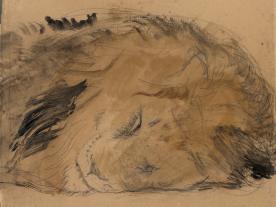
For Mar k Godowski
O anima Lombarda
Come ti stavi altera e disdegnosa
E nel mover de li occhi onesta e tarda!
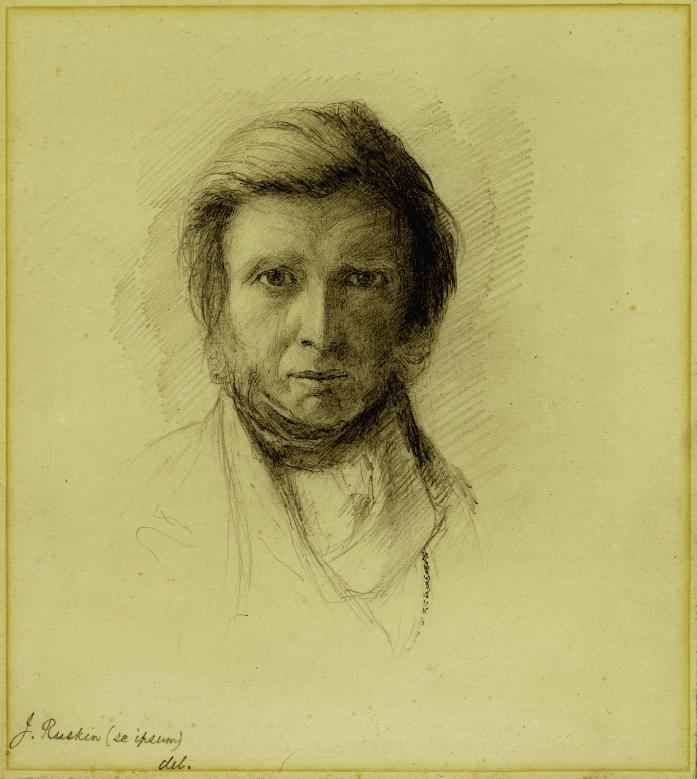
Opposite: Self-por trait, Spr ing 1874
Having long promised his Amer ican fr iend Char les Eliot Nor ton a por trait, Ruskin finally made two of himself in the spr ing of 1874, this pencil drawing and a watercolour (Wellesley College Librar y) The inscr iption –‘ se ipsum’ [by himself] – is in Nor ton’s hand Nor ton also added on the rever se ‘not a good likeness , ’ although it seems to moder n eyes a sensitive as well as an accurate image There has often been detected, in the eyes and fur rowed brow, an expression of the wor r y and sadness brought on at this time by the fluctuating relationship with Rose La Touche
A well-known Victor ian wr iter once proposed that, while philosopher s had previously been content to inter pret the wor ld, the real point was to change it. (For good and ill, he succeeded: his name was Kar l Marx ) John Ruskin, another major prose wr iter of the Victor ian age , inter preted the wor ld with an eye of unpar alleled keenness; he then went on to change the wor ld in many different ways, though ver y few people today are aware of quite how profound and multifaceted those Ruskinian changes have been. This shor t book, then, is an introduction to some of the ways in which Ruskin inter preted his wor lds, and some of the ways in which he changed them
Why ‘ wor lds’ r ather than wor ld? Because Ruskin was one of histor y ’ s great polymaths: he knew many things, and could do many things He is still best known as an ar t cr itic – probably the most influential ar t cr itic of any language , at any time –and on those grounds alone he should command our attention He championed Tur ner at a time when the conventional opinion was that the poor old man had lost his way, and the young Pre-Raphaelites at a time when people of taste considered them beyond the pale He drew fresh attention to the gener ally neglected painter s, sculptor s and architects of the past, and explained why their wor k still lived and could inspire . His contempor ar ies were astounded: some of them said that he seemed, quite simply, to have given them the gift of sight
This is already a ver y consider able accomplishment, but it is only a fr action of what Ruskin achieved in the fields of ar t and architecture He gave new direction and intelligence to the Gothic Revival in architecture; he r aged against the barbar ism with which old buildings were either br utally tor n down, foolishly neglected or ignor antly restored, and so established the moder n tendency in architectur al conser vation; he was a presiding spir it of the Ar ts and Cr afts movement, and, after his death, a beacon for many ver y different talents, from Fr ank Lloyd Wr ight to the designer s of the Bauhaus He was the fir st Slade Professor of Fine Ar t at Oxford, and thus helped establish histor y of ar t as an intellectual discipline in the English-speaking wor ld He taught wor king people and other s how to dr aw, and explained why that basic skill is so cr ucial to humankind
But the wor ld of the visual ar ts is not the only one Ruskin examined Long before he became a wr iter on ar t, Ruskin had been enchanted by the natur al wor ld – fir st of all the wor lds of rocks and stones (his ear liest passion, and the consolation of his troubled adult year s, was geology), then the clouds and the water s He watched all these things, drew them, pondered them, and thought about the invisible power s which had made them. (Another of Ruskin’s wor lds is the wor ld of religion – fir st of all, the Chr istian faith, but later the beliefs of the ancient Greeks, the ancient Egyptians and other cultures Theology and Mythology are two of his major concer ns.) It is hardly sur pr ising that he should have become his age ’ s single most impor tant wr iter on what we now call the environment, or ecology His late lecture ‘The Stor m-Cloud of the Nineteenth Centur y ’ now seems one of his most fr ighteningly acute statements about our present atmospher ic cr isis
Ruskin saw – the word deser ves emphasis, for one of Ruskin’s simplest and most ur gent messages for us is that we should lear n to see – he saw what was causing
that cr isis, as the Romantics had seen before him: in the immediate sense , the massive growth of industr y and its poisonous by-products; in the lar ger sense , insane , heedless greed Ruskin could easily have devoted his whole life to studying ar t and nature and never troubled himself about social conditions; but he was too honest to deny the evidence in front of his eagle eyes Looking at the histor y of Venice as made solid in its buildings, he became convinced that he could detect the r ise and fall of a nation in the health and the decadence of the architecture it had made Looking at the ugliness of contempor ar y Br itain – a latter-day Venice , a mercantile , sea-far ing power at the height of its pr ide – he saw little reason for thoughtful Br itons to be unduly proud.
Where other wr iter s might have been content to salve their ir r itated consciences with the occasional angr y essay or speech, Ruskin resolved to do something about the condition of Br itain, and the moder n wor ld in gener al A r ich man, he gave away almost all of his inher ited wealth to the causes and the people he suppor ted. He r isked his consider able social and academic standing by telling his wealthy fellow Br itons, loud and clear and often, that they were blind and evil He launched a body which would combat the Dr agon of laissez-faire capitalism, and called it The Guild of Saint Geor ge .
Was his cr usade victor ious? His own final verdict was probably a pessimistic one , but since his last year s were spent in near-silence , we will never know. Yet there is no reason for those of us who still read him to take a dispir ited view Directly or – more often – at two or three removes, so the source has not always been obvious – Ruskin has helped create some of the redeeming features of our own wor ld, and in ways both momentous and subtle One of his major disciples, for example , was Mahatma Gandhi, who said that reading Ruskin’s shor t tr act Unto This Last was the tur ning point of his life Ruskin’s other disciples r ange from Leo Tolstoy to Marcel Proust
For the Br itish, one of the most telling consequences of Ruskin’s doctr ines has been the creation of the moder n welfare state , whose architects – Bever idge , Attlee & Co – were all educated in the Ruskinian vein, at Toynbee Hall and elsewhere One of the fascinating par adoxes of Ruskin’s career is that he was, by his own – highly idiosyncr atic – definition, a Tor y: a believer in Kings and Queens, hier archy and obedience , piety and chivalr y. Yet from William Mor r is onwards, his keenest disciples have often called themselves Socialists Univer sal education for the young, public libr ar ies, care for the sick and the elder ly all these innovations and other s were either proposed or refined in Ruskin’s wr itings, and dismissed by Victor ians as sentimental or even mad
And then there is the pr ivate wor ld – or, again, wor lds – of Ruskin. As Sir Kenneth Clar k pointed out in the ear ly 1960s, Ruskin’s reputation took such a severe blow in the fir st par t of the twentieth centur y that he was all but entirely for gotten, save for some mean-spir ited gossip about his mar r ied life . That gossip continues, though now it is better infor med, thanks to a sequence of good and even great biogr aphies In mater ial ter ms, Ruskin’s life was blessed: not only was he wealthy, but he had wor k that enthr alled him and which he knew to be im por tant In emotional ter ms, he was often wretched: a loveless and ill-suited
mar r iage when he was in what should have been his pr ime gave way to a tormenting and unrequited year ning in his later life . As he grew older, he suffered more and more from illnesses –- mainly, one suspects, psychosomatic in or igin –and bouts of madness, culminating in a decade of silence and withdr awal.
Ruskin’s enemies have always liked to say that the madness of the last year s is already present in the eccentr icities and quir ks of the ear lier wr iting His admirer s see little if any connection, save in the sense that the savage indignation stir red in him by the vile things he saw may have been more than the most robust mind could bear. Ruskin was ferociously independent-minded, almost to the point of cantankerousness, but that is one of the things that makes reading him such an adventure: his thunderous eloquence unsettles all the stale and standard ideas that clutter up our heads. The wor ld of Ruskin’s prose is incompar ably str ange , and incompar ably r ich We can begin our jour ney by looking at how much Ruskin was a typical product of his age , and how far he became its living contr adiction

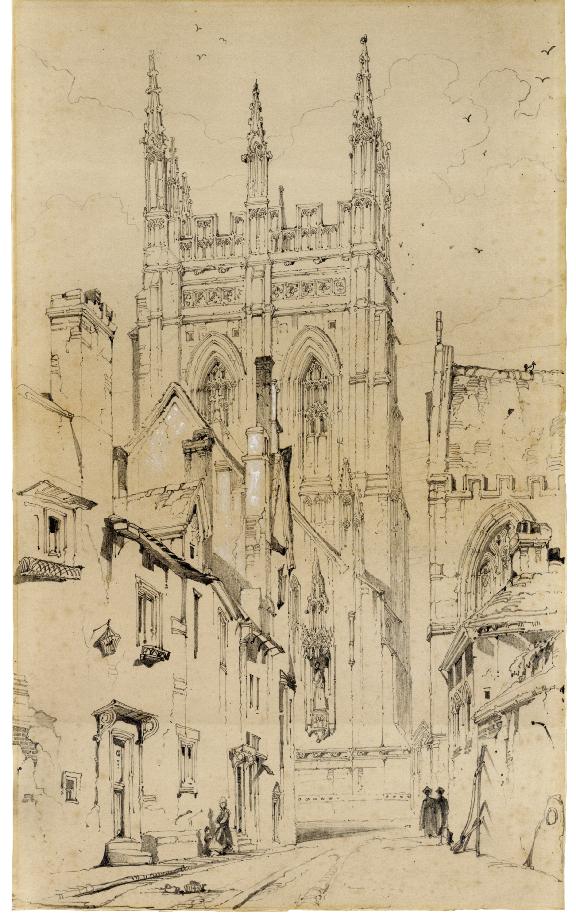
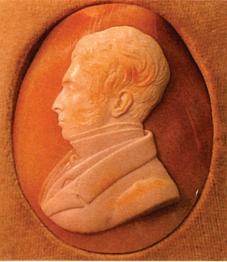
Cameo por trait of Ruskin by C R Franz, Rome, 1840 In Pr aeter ita, Ruskin recalled: ‘We bought, according to custom, some coquillage of Gods and Graces , but the cameo cutter s were also skilled in mor tal por traiture, and papa and mama, still expectant of my future greatness , resolved to have me car ved in cameo I had always been content enough with my front face in the glass , and had never thought of contr iving vision of the profile The cameo finished, I saw at a glance to be well cut, but the image it gave of me was not to my mind I should now descr ibe it as a Geor ge the Third’s penny, with a halfpennywor th of Geor ge the Four th, the pr ide of Amurath the Fifth, and the temper of eight little Lucifer s in a swept lodging’
I already disliked growing older, – never expected to be wiser, and for med no more plans for the future than a little black silkwor m does in the middle of its fir st mulber r y leaf – Praeter ita, 118
A few details of events in the ear ly 1830s.
Geor ge IV died in 1830, and William IV began his shor t reign The Manchester and Liver pool Railway opened in the same year. In Par liament, the Whigs came into power under Lord Grey A ter r ible choler a epidemic spread through the countr y, and continued into 1832, by which time more than 30,000 people had been killed by the disease . In 1831, a ser ies of r iots – the so-called ‘Swing’ r iots – broke out in r ur al areas, in protest at the increasing mechanization of agr iculture
Histor ians frequently cite the year 1832 as the bir th-date of moder n Br itain It was the year of the Great Refor m Bill, which, br iefly put, took some of the power away from the landed gentr y and passed it into the hands of the r ising commercial and manufactur ing interest (This process would continue throughout the centur y ) The fr anchise was greatly enlar ged and representation in Par liament restr uctured, so as to shift the balance of elector al power away from underpopulated r ur al areas and towards the new cities
The temper of the age was growing more humane , at least in some respects. In the following year, 1833, slaver y was abolished throughout the Br itish Empire , and the Factor y Act put limits to child labour 1833 was also the beginning of the Oxford Movement in the Anglican Church – idealistic men with keen minds and keener consciences began to wor r y about the legitimacy of their beliefs, and to tur n away from Canterbur y and towards Rome (An Act of Roman Catholic Emancipation had been passed in 1829.) In the scientific sphere , one of the great events of the ear ly decade was the publication in 1830 of Sir Char les Lyell’s Pr inciples of Geology – the book that Char les Darwin took with him on the HMS Beagle voyage , and which shaped his thinking on the matter of evolution
Opposite: Mer ton College and Magpie Lane, Oxford, c 1838 Ruskin was already a good draughtsman when he entered Oxford Univer sity, and his architectural studies were much admired His older fr iend at Chr ist Church, Char les Newton, asked him to make a drawing for the Oxford Society for the Preser vation of Gothic Architecture (of which Ruskin was a founder member in 1839), but ‘had to point out to me that my black dots and Proutesque breaks were no manner of use to him, and that I must be content to draw steady lines in their exact place and propor tion’
As a sheltered boy, leading what he later descr ibed (not without fondness) as a kind of monastic life in the London suburbs, John Ruskin would have known of these things mainly through the disapproving conver sation of his parents As Tor ies, with a sentimental weakness for ar istocr ats (by our lights, and by the lights of Ruskin himself as he grew older, they were snobs, albeit of a r ather naïve and well-intentioned kind) the older Ruskins would no doubt have been distressed by the spir it of Refor m As Protestants from an Evangelical background, they would have been alar med at the revival of what they saw as Romish ways. It was one of the great dreads of Mar garet’s later life that her son, steeped as he was in the ar ts of Italy, might go over to Rome .
Still, if Ruskin was over-protected by his str ict but ador ing parents, he was not star ved of stimulation or knowledge
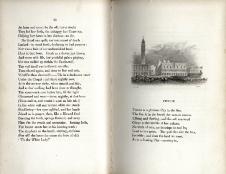
Above, a typical opening from Roger s ’ Italy, 1830 Below, two vignettes from Ruskin’s account of his fir st tr ip to the Continent in 1833, which he laid out in imitation of Roger s ’ book: an English family at Calais; and (bottom) a traveller contemplating the Alps
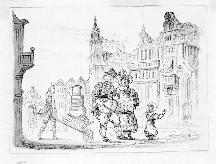
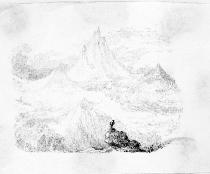
Since he was still being schooled at home , John was free to continue accompanying his father on tr ips around the countr y. And since many of his father’s customer s were wealthy, he saw a good deal of the nation’s gr ander houses, and the ar t collections they often displayed. The habit of sketch-making and note-taking was already well ingr ained in him, and he lear ned ear ly how to conver t a rented hotel bedroom or a guestroom into a ser viceable study And his home schooling was becoming at once more r igorous and more var ied. In 1831 he seems to have begun studying Hebrew with his mother, though there is little evidence that he ever mastered the language He also began dr awing lessons with a Mr. Char les Runciman, on whom he later looked back with disapproval. ‘Mr Runciman’s memor y sustains disgr ace in my mind in that he gave no impulse or even indulgence to the extr aordinar y gift I had for dr awing delicately with the pen point.’ Following his unabated fascination for geology, John also compiled a Dictionar y of Minerals
The year of the Great Refor m Bill, 1832, was momentous in Ruskin’s young life for ver y different reasons One was that he managed to complete The Iter iad, which stretched to 2,000 lines – a creditable wor k, but not an astonishing one Far more significant than this poetic wor k was his ear liest revelation of the power of ar t, and of one ar tist in par ticular He was given a copy of Samuel Roger s ’ topogr aphical poem Italy, with illustr ations by J. M. W. Tur ner. As he put it: on my thir teenth (?) bir thday, 8th Febr uar y 1832, my father’s par tner, Mr Henr y Telford, gave me Roger s ’ Italy, and deter mined the main tenor of my life ’ [The question mar k introduced by Ruskin after the date is explained a few lines later : ‘I have told this stor y so often that I begin to doubt its time .’]
In the following year, 1833, the Ruskins made their fir st major tr ip to the continent. They had been planning it, with great, almost child-like excitement, for at least two year s It was to be Ruskin’s fir st exposure to some of the places and sights which would later be sacred to him, including Chamonix, though it was on their next Continental tour, two year s later, that the tr ue force of these visions took hold of him At a summer dinner par ty in Par is, he met the gir l who would soon be his fir st love , Adèle Domecq; at this time there were no intimations of the amorous woes ahead for him On 21 September : the family were back in Her ne Hill; Ruskin settled down to wr iting a poetic account of the summer tour, taking Roger s as his model.
Realising the limitations of the education he had so far received, in 1834 his parents sent John to a school r un by the evangelical Reverend Thomas Dale in Camberwell, just a shor t walk from Her ne Hill Dale was a severe master, and Ruskin did not greatly enjoy his hour s there He felt more kindly disposed to the pr ivate tutor, Mr Rowbotham, who now began to coach him two evenings a week – par ticular ly on French gr ammar, and on Euclid and algebr a Mr Rowbotham took him as far as quadr atics, ‘ but there I stopped, vir tually, for ever. ’
In September, his fir st prose wor k ‘Enquir ies on the Causes of the Colour of the Rhine’ was published in J. C . Loudon’s Magazine of Natural Histor y: a ver y
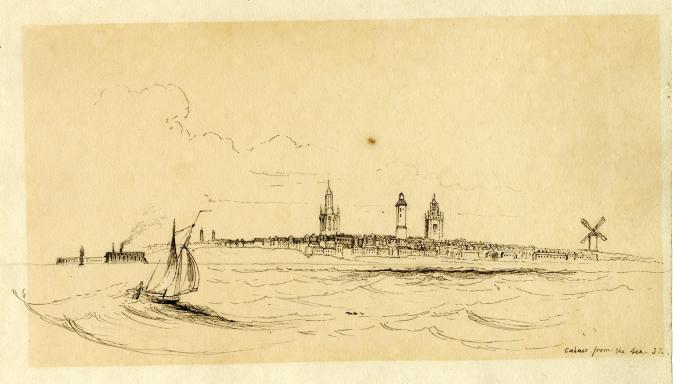
Calais from the sea, 1835 This drawing probably dates from June1835, but Ruskin never for got the impression his fir st visit to Calais made on him as a boy of four teen, two year s ear lier : ‘Stand on the pier and look round you The sky is a French sky, it is a ver y turquoise, the sea is a French sea in ever ything but its want of motion, the air is French air, none of your English boisterous sea puffs which blow the dust in your eyes when you wish to be par ticular ly clear sighted’
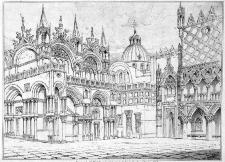
Par t of St Mar k’s Church and Entrance to Doge’s Palace, Venice, 1835 Ruskin saw Venice for the fir st time on the 1835 tour This is one of the few drawings known to have been made dur ing the family’s week there in October ; appropr iately it includes par t of the Doge’s Palace, which he would later call ‘the central building of the wor ld’
reputable place for a ver y young ‘scientist’ (to use a word that had only been coined in recent months)
In March 1835 John began his fir st exercises in oil painting, but this, and all of his other studies, was suddenly disr upted by a severe attack of pleur isy He was taken out of Dale’s school for a while . By the ear ly summer he was sufficiently well to accompany his parents on their second major continental tour, which began on 2 June It was when the family ar r ived at Abbeville that Ruskin enjoyed what amounted to an epiphany. As he wrote , in a famous passage of his autobiogr aphy:
...there have been, in sum, three centres of my life’s thought: Rouen, Geneva, and Pisa All that I did at Venice was bye-wor k, because her histor y had been falsely wr itten before , and not even by any of her own people under stood; and because , in the wor ld of painting, Tintoret was vir tually unseen, Veronese unfelt, Car paccio not so much as named, when I began to study them; something also was due to my love of gliding around in gondolas But Rouen, Geneva and Pisa have been tutresses of all I know, and were mistresses of all I did, from the fir st moments I entered their gates.
In this jour ney of 1835 I fir st saw Rouen and Venice – Pisa not until 1840; nor could I under stand the power of any of those great scenes till much later But for Abbeville , which is the preface and inter pretation of Rouen, I was ready on that 5th of June , and felt that here was entr ance for me into immediately healthy labour and joy
In the same tr ip, he enjoyed his fir st, momentous view of the Alps.

Mount Pilatus , Lake Lucer ne, 1835-6
A rare example of Ruskin conver ting one of his 1835 Swiss pencil drawings into a watercolour in the fashionable style of the per iod, taken to a degree of completion unusual in his subsequent output Quite apar t from a deep-seated belief in absolute tr uth to nature, throughout his life Ruskin was never happy drawing without the subject in front of him
In the public sphere , the most significant event of the year was the publication of his poem ‘Salzbur g ’ in Fr iendship’s Offer ing He was taking the ver y fir st steps towards a wr iter’s career. On 4 Febr uar y 1836 he registered at King’s College , London as an ‘Occasional Student’ of English Liter ature Soon, though, he would have other things to occupy his attention
It seems that Mr Domecq and the Ruskins may have discussed the advantages of an eventual mar r iage between their families; at any r ate , there seemed to be gener al approval for the idea that John might begin to cour t one of the four Domecq daughter s when they came to stay at Her ne Hill: ‘[Adèle-]Clotide , a gr aceful ovalfaced blonde of fifteen; Cécile , a dar k, finely-browed, beautifully-featured gir l of thir teen Elise , again fair, round-faced like an English gir l, a treasure of good nature
Henr y Acland, 1853, by John Everett Millais Drawn on the ill-fated holiday in Glenfinlas , when Acland joined Ruskin, his wife Effie and the painter Millais; Ruskin repor ted to his father that Millais had thought Acland’s head noble and wor th drawing

and good sense; Caroline , a delicately quaint little thing of eleven.’ Almost at once , Ruskin was smitten by Adèle-Clotide – or, as she was usually called, Adèle .
‘Anything more comic in the exter nals of it, anything more tr agic in the essence , could not have been invented by the skilfullest designer in either kind’, he later wrote Not greatly accomplished at char ming even his school-mates at Dale’s, Ruskin was hopelessly at sea with pretty gir ls, especially pretty gir ls with Par isian dresses and sophistication. Ever y attempt he made to impress Adèle was doomed; he appeared gawky, pedantic , r idiculous He resor ted to composing a dashing tale of romance , and had it published in Fr iendship’s Offer ing. Result: ‘Adèle laughed over it in r ippling ecstasies of der ision ’
In his old age , Ruskin was able to make this awful, humiliating episode into a wr y comedy:
The entirely inscr utable thing to me , looking back on myself, is my total want of all reason, will, or design in the business. I had neither the resolution to win Adèle , the cour age to do without her, the sense to consider what was at last to come of it all, or the gr ace to think how disagreeable I was making myself at the time to ever ybody about me There was really no more capacity nor intelligence in me than in a just fledged owlet, or just open-eyed puppy, disconsolate at the existence of the moon
But it would be hard to over state his degree of emotional distress at this failure in love . He was never to know any protr acted happiness in love , and from time to time would admit to confidants, such as Char les Eliot Nor ton, that his inability to find and win an appropr iate woman was one of his life’s deepest sor rows. It was for tunate for him that he did at least possess a nascent gift for fr iendship, and was soon to have a chance to exercise it
Those for tunate enough to have been educated at a distinguished univer sity – or even a not so distinguished one – sometimes look back on their three or four under gr aduate year s as an unequalled golden age of exciting intellectual challenge and r apid per sonal development, unprecedented freedoms, fer vent fr iendships and, for the ver y lucky, ear ly love For the less intellectually ambitious, it can at least offer a pleasant holiday between the dr udger y of school and the tedium of routine adult wor k. Ruskin’s exper iences were unlike either of these . By and lar ge , Oxford left him unenchanted, and though he did not actively dislike his time there , he cer tainly did not blossom.
The fr iends he began to make included two lasting ones: Henr y Acland, a medical student who went on to become Regius Professor of Medicine at Oxford, remained close to Ruskin for the rest of their lives, and often took Ruskin’s side in controver sies; and Edward Clayton, later the addressee of Ruskin’s Letter s to a College Fr iend Such contacts apar t, perhaps his pr incipal gain from his year s at the Univer sity was the development of a cer tain social polish that he had previously lacked After some initial rough-housing and banter, he r ubbed along sur pr isingly well with the r ich and hear ty young bloods of Chr ist Church.

Diagram used to illustrate the second of Ruskin’s 1853 lectures in Edinbur gh It shows how a pointed arch can be both practical – having sufficient depth to incorporate a sash window – and decorative, especially if that decoration draws on natural for ms for inspiration: ‘It is the glor y of Gothic architecture that it can do anything ’ Both Effie and Millais also wor ked on the diagram
did not foresee its long after life , he was already the author of a shor t text which would go on to have a more substantial influence on the wor ld than anything in the five volumes of Moder n Painter s
Volume Two of Stones contained a chapter entitled ‘The Nature of Gothic’ The significance of this essay was far-reaching and dr amatic It was, for example , an inspir ation to the best Br itish architects of the Gothic Revival: Butterfield, Waterhouse , Street But it also encour aged less talented men towards the thoughtless gr afting of some superficial tr appings and stylistic details of Gothic architecture on to buildings which had no other Gothic dimension – and par ticular ly not what Ruskin saw as its spir itual well-spr ings It was this type of bogus Gothic against which he would later thunder in his Br adford lecture , ‘Tr affic’

1850-1860:
But the real potency of ‘The Nature of Gothic’ lay not in its aesthetic ar guments but in its ethical outr age:
The great cr y that ar ises from all our manufactur ing cities, louder than any fur nace blast, is all in ver y deed for this, – that we manufacture ever ything there except men; we blanch cotton, and strengthen steel, and refine sugar, and shape potter y; but to br ighten, to strengthen, to refine , or to for m a single living spir it, never enter s into our estimate of advantages
Or, again:
We have much studied, and much perfected, of late , the great civilized invention of the division of labour ; only we give it a false name . It is not, tr uly speaking, the labour that is divided; but the men: – Divided into mere segments of men – broken into small fr agments and cr umbs of life; so that all the piece of intelligence that is left in a man is not enough to make a pin, or a nail, but exhausts itself in making the point or the head of the nail
‘Gothic’ soon took on a separ ate life from the rest of Stones A few months later, in 1854, the philanthropist F J Fur nivall asked Ruskin for per mission to repr int the chapter as a pamphlet, which might be given free of char ge to all students of his newly founded Wor king Men’s College in London Ruskin agreed, and so began a long relationship with that College Thir ty-eight year s later, William Mor r is reissued it as a handsome volume from his Kelmscott Press. Mor r is had fir st read it when it was br and new
William Mor r is – by gener al agreement the most profound, appealing and heroic of Br itish Socialists, as well as a poet, designer, pr inter and many other things –always professed his undying gr atitude to the ‘Tor y ’ Ruskin, and, for all his dislike of master s, nonetheless refer red to him as ‘Master’. They did not know each other well, and met only a few times – Ruskin was much closer to their mutual fr iend Edward Bur ne-Jones – but their mutual regard was war m and endur ing Ruskin despised Socialism, as he under stood it, yet it can be ar gued that Mor r is (who would eventually became a full-blooded socialist some three decades later, in the 1880s) did more than many avowed Ruskinians to make the Master’s hopes into realities. One of Mor r is’s contempor ar ies at Oxford, where he was an under gr aduate at Exeter College from Januar y 1853 until he took his pass degree in the autumn of 1855 and his B A in 1856 (and where he met Bur ne-Jones) recalled the impor tance of Ruskin’s wr itings for idealistic young men:
It was when Bur ne-Jones and he [Mor r is] got at Ruskin, that strong direction was given to a tr ue vocation... Mor r is would often read Ruskin aloud. He had a mighty singing voice , and chanted r ather than read those welter ing oceans of eloquence as they have never been given before or since , it is most cer tain The descr iption of the Slave Ship, or of Tur ner ’ s skies, with the burden ‘Has Claude given this?’ were declaimed by him in a manner that made them seem as if they had been wr itten for no end but that he should hur l them in thunder on the head of the base cr iminal who had never seen what Tur ner saw in the sky.
Panorama of Thun, 1854 Mur ray ’ s Handbook descr ibed Thun as ‘ a ver y cur ious old town [which] contains within its walls nothing especially wor thy of notice ’ Ruskin always liked the place, par tly for its associations with Tur ner (the lake at Thun was ‘ a quite favour ite subject of Tur ner ’ s; his fir st sketch of it from Nature used to hang in my mother’s room’) but also for its simplicity. Ruskin was always happy in Thun, and the visit in 1854 was no exception ‘I have had a lovely walk this after noon through the streets of Thun in the balmy air, all the people at their windows , looking happy and quaint, and full of interest,’ he wrote in his diar y There are near ly twenty known drawings of the Swiss town, many of which, like this example, are given a distinctive blue tonality, and concentrate on the var ied inter locking roofs
Mor r is had already read the two volumes of Moder n Painter s before coming up to Oxford; it was the newly published second volume of Stones that str uck like lightning – and not for Mor r is alone As Fiona McCar thy notes, Stones ‘ was an Oxford book, the Oxford book of that whole per iod...’ Mor r is called it ‘ a revelation.’ In his reading of this book we can find the roots of vir tually his entire career in ar t and politics, including his establishment of a Society for the Protection of Ancient Buildings. Reading it was a tur ning point in Mor r is’s life .
In his introduction to the Kelmscott edition, Mor r is explained that ‘the lesson Ruskin teaches us, is that ar t is the expression of man ’ s pleasure in his labour.’ Mor r is went on to proclaim that it was ‘One of the ver y few necessar y utter ances of the centur y To some of us when we fir st read it, now many year s ago, it seemed to point out a new road on which the wor ld should tr avel.’ As Clive Wilmer has justly pointed out, though Mor r is does not give it, the name of that road is Socialism
Back in London for the new year, 1854, Ruskin began proper wor k on Moder n Painter s III, and continued to sit for Millais’s por tr ait But his mar r iage was cr umbling by the day. Effie was isolated and wretched at Her ne Hill, and Ruskin often spoke to her har shly She wrote a ser ies of increasingly despair ing letter s back to her family Eventually she was dr iven to make the most humiliating confession: on 7 March, she finally wrote to her father : ‘I have therefore simply to tell you that I do not think I am John Ruskin’s Wife at all!’
Mr Gr ay resolved to come to London and confront the Ruskin family. They ar r ived in London on the 14 Apr il and, on the 25th, took Effie back to Scotland with them Ruskin saw the par ty off at King’s Cross, to all appear ances unaware that this was a final break with his wife . On the same day, he was ser ved with a citation to Cour t in a suit for the annulment of their mar r iage He does not seem to have been ver y shocked – evidence , scholar s think, that he had planned it
On 9 May, he left for the continent with his parents By the 24th they were at Char tres They moved on to Switzer land, where Ruskin contemplated the mountains with a sense of recovered serenity, and spent many hour s dr awing. These few weeks had a per vasive influence on the next two volumes of Moder n Painter s
On 10 July, in Chamonix, he wrote: ‘Thank God, here once more , and feeling it

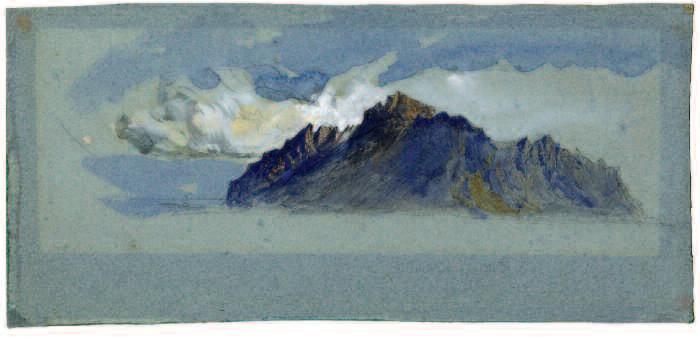
Mount Pilatus , probably drawn in 1854, when Ruskin escaped from his divorce proceedings to the Alps He had a par ticular fondness for the range of low mountains over looking Lake Lucer ne, centr ing on Mount Pilatus , and drew them many times: ‘wherever you see it, its for m is always beautiful’
more deeply than ever I have been up to my stone upon the Breven, all unchanged, and happy’
Dur ing their absence , the law was moving with uncommon alacr ity On 15 July, the ‘pretended mar r iage’ was declared a ‘nullity’ since ‘the said John Ruskin was incapable of consummating the same by reason of incur able impotency’. It seems likely that this was a matter of legal for m, allowing the mar r iage to be annulled without publicity (unlike a divorce) so that each side could star t life afresh (Effie mar r ied Millais the following year, and went on to have eight children with him.) Whatever the tr uth, Ruskin was intensely happy On 13 August he wrote ‘How little I thought God would br ing me here again just now – and I am here , stronger in health, higher in hope , deeper in peace than I have been for year s. ’
The family retur ned to London on 2 October, and Ruskin applied himself steadily to wr iting, though he also went out a good deal more than had previously been his habit In December, the Glenfinlas por tr ait, finally completed, was hung at Denmar k Hill Ruskin wrote a civil note to Millais, who replied that he found it sur pr ising that Ruskin should wish their fr iendship to continue .
All that autumn and winter, Ruskin, after discussing the matter with Fur nivall, found a new preoccupation: lectur ing on ar t at the Wor king Men’s College in Red Lion Square On 2 November he began a ser ies of weekly lectures on dr awing which he continued, at inter vals, for the next five year s From this humble beginning came all manner of – mostly happy – consequences. Some of Ruskin’s students went on to wor k for him in a var iety of ways in later life; other s made successful career s as fine cr aftsmen (though this was not Ruskin’s pr imar y ambition for gr aduates of the College)
This regular contact with intelligent, thoughtful, decent wor king men gr adually


Study of Two Stones: another undated drawing exercise; possibly the two fossilised sea urchins descr ibed in Elements of Dr awing, exercise VIII
Opposite: Study of a Velvet Crab, undated Ruskin placed this extremely delicate colour study in the Elementar y Zoology section of the Educational Ser ies of drawings given to the Oxford Drawing School
fir st major wr iter to note that the pollutions of industr y might damage not merely the air over factor y towns but the climate of our whole wor ld
Ruskin’s later wor ks on natur al histor y – Prosperpina on flower s, Deucalion on rocks and stones, and Love’s Meinie, on birds – are , as their flavour some titles might suggest, wor ks of great idiosyncr asy, in which Ruskin dar ts r apidly from the kind of close obser vation that or thodox science might accept, to for ays into recondite symbolism On the swallow: ‘It is an owl that has been tr ained by the Gr aces It is a bat that loves the mor ning light It is the aer ial reflection of a dolphin. It is the tender domestication of a trout...’ You will not find wr iting of this kind in, say, Darwin, and it plain that Ruskin, though he had a good deal of time for the biologist on the couple of occasions they met, was no great fan of Darwin’s theor ies.
Some of his ar guments, or at any r ate his satires against Darwin can be found in the ser ies of Oxford lectures collected under the title The Eagle’s Nest. They are not always easy to follow, being compounded at var ious times of mocker y, sarcasm, fantasy and piety – especially the last, for one of Ruskin’s objections to Darwinism (as he under stands it) is that it flatter s human ar rogance . Here is a sample: ‘ it is appointed that ver tebr ated animals shall have no more than four legs, and that, if they require to fly, the two legs in front must become wings, it being against law that they should have more than these four member s in r amification from the spine Can any law be conceived more arbitr ar y, or more apparently causeless? What strongly planted three-legged animals there might have been! What symmetr ically r adiant five-legged ones! What volatile six-winged ones! What circumspect seven-headed ones! Had Darwinism been tr ue , we should long ago have split our heads in two with foolish thinking, or thr ust out, from above our covetous hear ts, a hundred desirous ar ms and clutching hands; and changed our selves into Br iarean Cephalopoda ’ Not ver y sound science , perhaps; but not bad rhetor ic .